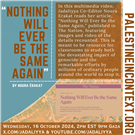This weekend, the Harvard University community will host its conference, "One-State Conference: Israel/Palestine and the One-State Solution". The conference promises to be an invigorating discussion on the likelihood of the two-state solution, the benefits of the one-state solution, and the challenges to achieving either. In light of that discussion, I thought it useful to share the legal dimensions that demonstrate Israel’s discriminatory system both within its putative borders and the Occupied Palestinian Territory (OPT) as a singular Apartheid regime. The unitary nature of this legal system at once triggers proper legal remedies in international law and underscores the pragmatic thrust of the one-state solution.
Since its establishment, Israel has bifurcated Jewish nationality from Israeli citizenship. Indeed, there is no such thing as Israeli nationality. Instead, the Citizenship Law of 1952, inaccurately termed “Nationality Law,” repealed the Palestinian Citizenship Order of 24th July 1925 under which the indigenous Palestinians were granted the status of citizens and nationals in their country; it resulted in the de facto “denationalization” of this entire population. Henceforth, Israeli law has distinguished between its Jewish population who are both “nationals and citizens” from its non-Jewish population, namely Palestinian Muslims and Christians, who are “citizens-only.” This distinction aims to privilege the rights of Jewish-nationals wherever they may reside and/or abridge the rights of non-Jewish nationals (Palestinian Arabs), regardless of their status as citizens of the State, residents of East Jerusalem, civilians living under occupation in the OPT, or refugees living in exile, with regard to residency rights, land ownership, freedom of movement, nationality, citizenship and the right to leave and return to one’s country.
Israel’s binary system facilitates the State’s stated goal of maintaining a significant Jewish majority even in the face of natural population growth. Within the State there exist approximately 1.2 million Palestinian-Israelis who constitute twenty percent of the population. Given the State’s steadily declining Jewish population and considering the Mandate Palestine as a whole, Palestinian Christian and Muslims will outnumber their Jewish counterparts by 2025. Despite its stated commitment to be both Jewish and democratic, Israeli institutions prioritize the State`s Jewish character above all else, even, and often, at the expense of its democratic one. This amounts to a set of laws, policies, and judicial decrees within the State and the OPT aimed at reducing the presence of non-Jewish nationals, namely a policy of forced population.
The Law of Return (1950) defines a Jewish national as someone born of a Jewish mother or has become converted to Judaism and is not a member of any other religion. Said nationality confers exclusive rights and privileges including the right to enter Israel at any time, to obtain citizenship at any time, and to live in Israel and/or the settlements in the West Bank. In practice, this distinction affords more rights to Jewish nationals living outside Israel who have never visited or cared to visit the State than it does the State’s own non-Jewish citizens.
Israel’s efforts to maintain a Jewish majority drives its policy of forced population transfer throughout Mandate Palestine. Population transfer seeks to alter the demographic composition of an area by moving people into and/or out of the area. Specific components of the policy of population transfer amount to war crimes under the Rome Statute (arts. 7 and 8) and the Geneva Convention IV (arts. 49 and 147). The Sub-Commission on Prevention of Discrimination and Protection of Minorities of the former Commission on Human Rights has clearly defined population transfer as:
the movement of people as a consequence of political and/or economic processes in which the State Government or State-authorized agencies participate. These processes have a number of intended or unintended results that affect the human rights of the transferred population, as well as the inhabitants of an area into which settlers are transferred. (…) The State’s role may involve financial subsidies, planning, public information, military action, recruitment of settlers, legislation or other judicial action, and even the administration of justice.
This policy is as prevalent within the West Bank as it is within Israel. In both instances, it aims to facilitate the migration and settlement of Jewish nationals whilst ensuring their dominant and legal status at the expense of the rights of Palestinian Arabs in order to compel and/or enforce their forcible displacement. Said policy, together with other policies based on the distinction between Jewish nationals and non-Jewish nationals, specifically violates Articles II(c) and II(d) of the Apartheid Convention.
Israel’s discriminatory land laws constitute a core component of the policy of population transfer. This litany of laws begins with the Absentee Property Law (1950), which authorized the State to establish a Custodian to confiscate the lands of those persons deemed absentees or present absentees. Absentees refers to those refugees who fled during the war and who were denied entry as a matter of fact. Similarly, present absentees refers to those Palestinians who fled their homes but remained within Israel, also known as internally displaced persons. They too were not permitted to lay claim to their homes and lands. Under the Absentee Property law, the Custodian transferred the lands to the Development Authority (DA) whose purpose was to “to work with relevant Government agencies to acquire and prepare lands for the benefit of newly arriving Jewish immigrants.” Under the law, the DA may transfer acquired land only to the State and the Jewish National Fund (JNF) to be used for the exclusive benefit of the “Jewish people.” Through this land law, Israel has transferred ninety-three percent of Palestinian lands owned or collectively held by Palestinians before 1948 into ‘Israel lands’ and cannot be challenged in court because it has been nationalized. Consider that Palestinian-Israelis who constitute one-fifth of the population use or control 3.4 percent of the land today.
More contemporary laws include the 2003 Temporary Amendment to the Citizenship and Entry into Israel Law. This law suspends the possibility of Palestinian citizens of Israel and Jerusalem ID-holders gaining permission, through family reunification, to legally live in Israel or occupied East Jerusalem with their spouses from the OPT or from purported “enemy states.” In May 2002, Israel issued decision 1813, which froze the applications for all Israeli citizens or East Jerusalem residents that involved Palestinian spouses from the OPT, to prevent the possibility of a "creeping right of return" through the unification process. The Knesset institutionalized this policy through law in 2003 when it passed the Temporary Law. Since the overwhelming majority of Israeli citizens wishing to marry spouses from the OPT are Palestinians, the law is disproportionately discriminate against Palestinians and violates the right to family life. Moreover, the 2003 amendment does not change the situation for Israeli citizen spouses applying to be joined either by foreign spouses or Israeli settler spouses living in the OPT. On 11 January 2012, Israel’s High Court rejected a legal challenge to the law holding that “human rights are not a prescription for national suicide.” Though the Court held that the law furthers Israel’s national security, it applies the prohibition on family reunification as a blanket policy without the opportunity for due process. Israeli Knesset Member Otniel Schneller explained the legislation`s discriminatory intent when he said “the decision articulates the rationale of separation between the (two) peoples and the need to maintain a Jewish majority… and character of the State.”
In the Negev desert, the State is applying a much more blatant policy of forced population. The Prawer Planproposes to remove thirty thousand Bedouin Palestinian-Israeli citizens and place them in urban townships, to make room for a forest and housing units for Jewish-nationals. Palestinian residents of Al-Araqib have fastidiously resisted this plan by rebuilding their homes demolished no less than twenty-five times by their State. In defiance of human rights norms and decency, the State has sued the residents for the cost of the demolitions.
In East Jerusalem of the Occupied West Bank, Palestinians, who are afforded residency rights but not citizenship, are also subject to forced population transfer. According to Israel’s Jerusalem municipal planning document, Jerusalem 2000, the State seeks to reduce the ratio of Jewish nationals to non-Jewish Palestinian residents from 60:40 to 70:30 by 2020. Israel aims to achieve this demographic transformation by implementing a confluence of policies that include tenuous residency status subject to arbitrary revocation, systematic home demolitions, discriminatory housing and planning policies, and institutionalized land confiscation without compensation. Consider that between 1967 and 2010, Israel revoked the residency of 13,115 Palestinian Jerusalemites without due process or review in what amounted to ‘silent deportation.’ In December 2011, Jerusalem’s Mayor has suggested that those 55,000 Palestinian Jerusalemites who have found themselves on the Palestinian side of Annexation Wall should lose their residency status as well. The UN Special Rapporteur on Adequate Housing found that Israel’s policies amount to a Judaization campaign.
Throughout the West Bank, Israeli forced population transfer is no less insidious. The Jordan Valley, which constitutes forty percent of the West Bank, has all but been declared a closed military zone and has been the site of systematic displacement. There, Israeli authorities have accelerated settlement expansion and settler implantation. Additionally, the State has severely restricted access to the Valley’s water for the exclusive use of its military apparatus and settler population forcing indigenous Palestinians to move for survival. According to the Office for the Coordination of Humanitarian Affairs, Israel is implementing similar policies to solidify its control and facilitate the displacement of Palestinian Arabs living in Area C, which constitutes sixty two percent of the West Bank.
The de facto reality of Israel’s control over the entirety of the OPT has not been lost on Israelis who have urged for the unilateral annexation of the West Bank in contravention of international law and human rights norms. While the community of nations continues to distinguish between Israel Proper and the OPT, Israel makes no such distinction as it privileges its Jewish nationals and/or abridges the rights of Palestinian Arabs throughout Mandate Palestine regardless of citizenship or residency status. This unitary policy towards the land’s Palestinian Arabs puts into question the adequacy of Occupation Law, alone, to redress the ongoing and egregious violations committed by Israel.
Consider that even if a two-state solution were to be established on the 1967 borders, how does that solution address the rights of those non-Jewish nationals who are citizens of the State and subject to forced population transfer and treatment as a fifth column within the State? Moreover, how does such a solution address the rights of Palestinian refugees who are not eligible for Jewish nationality under any circumstances and therefore institutionally precluded from the benefits of the Law of Return including entry, citizenship, and residency? Instead, legal scholars and advocates suggest that human rights law mandating equal treatment is necessary to comprehensively treat this endemic.
Beyond appropriate legal regimes is a question of pragmatism. While two-state adherents emphasize the pragmatic nature of the two-state solution relative to the idealistic proponents of a single and democratic state, the facts on the ground demonstrate firstly, the inextricable population distribution of Palestinian Arab and Jewish populations. Indeed, the Gaza Strip may be the only territory where there exists a homogenous population. In light of this, achieving a two-state solution will not only necessitate land swaps but population transfers of Jewish and Palestinian populations as well. Such transfers should be opposed by the international community as they are likely to fuel accelerated ethnic cleansing policies akin to those seen in the former Yugoslavia. Advocating for equality among citizens of a single state is arguably more practical than is supporting the forced removal of ethnic populations aimed at achieveing homogeneous ethno-national entities. In a quickly shifting Middle East where citizenship, democracy, and plurality have gained increasing salience it is especially troubliing to advocate for reverse trends in Israel and the OPT. Not only is the two-state solution insufficient to treat Israeli violations of Palestinian rights, but it is impracticable as well.
[To read a robust analysis of these laws and the policy of forced population transfer, read BADIL’s Submissionto the 80th Session of the Committee for the Elimination of Racial Discrimination.]











